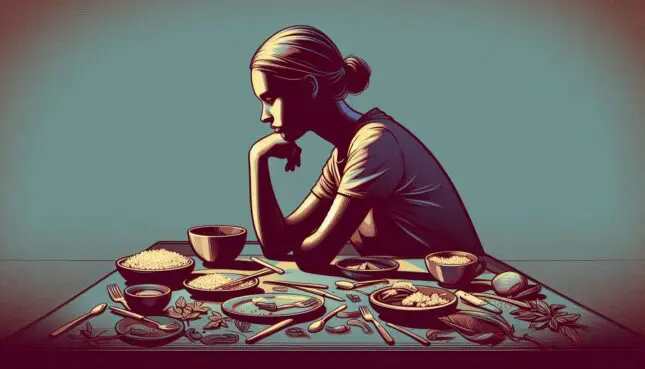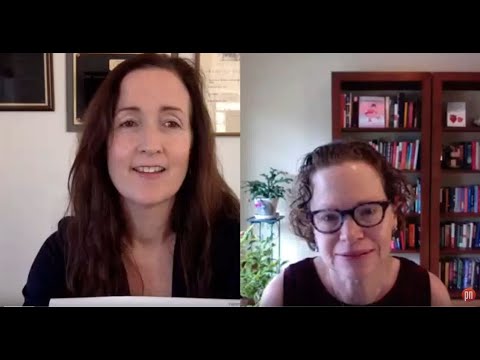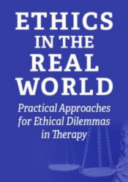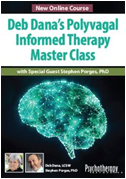I rarely work with eating disorders, if I can help it. My own history was so painful, shame-ridden, and protracted, that I fear I won’t have the patience or sufficient compassion to bear witness to its agonies. In my long life, I have seen the progression of food fads, diet and weight loss programs, “treatments” and often costly and lucrative products and regimens claiming to be a magic bullet for what, in my experience, was a trauma-dysregulation symptom. I will start with the happy ending: for the past 25 years or so, I have been blessedly free of the tyranny and the 24/7 nightmare of the food obsession and compulsion. I am infinitely grateful. Of course, I’ll always remember how it was.
Beginning when I was probably three or four, I was constantly referred to as a “bad eater.” I didn’t like meat, and it was a perpetual fight to get me to eat it. I remember scenes of my mother chasing me around the table, brandishing a large serving spoon which she occasionally used to give me a whack. My great Aunt Gertrud, who took care of me when I was small, called me a “dickkopf,” which roughly translates to “stubborn mule,” for being so impossible around food. My parents both had histories of true hunger. My dad told us stories of “bread and worms,” and how when he first arrived in the U.S. he was overcome with awe and wonder at the abundance on grocery store shelves. He told us he could not stop drinking milk, simply because he could. Of course, I felt terrible guilt and shame about my privilege, and about my unreasonable insistence of eating and not eating what I wanted. In those days it was common to say to children, “Clean your plate! Children are starving in Europe!” And like many kids, I wondered how my eating all my food would help them.
By the age of 11, I discovered that not eating was an effective way to numb out, or even experience a kind of light-headed high. It was also 1966, when the supermodel on all the magazine covers was Twiggy, the rail-thin sensation. Her extreme androgenous skinny-ness and long eyelashes made her the icon of the “London Look,” which compelled adolescent girls. So it was rather cool getting skinnier and skinnier. And because I was invisible anyway, nobody noticed that my little body was rapidly disappearing until quite late. I had hit 79 pounds, which on my then-five-foot, four-inch frame was pretty Twiggy-like. Passing out in a public place was unavoidably conspicuous, and my parents were compelled to notice. I couldn’t stand on my feet, let alone walk down the hall to the bathroom from my bedroom, where I convalesced for about a month. They were upset with me for doing this to myself, and to them. In those days there was really no awareness of anorexia or eating disorders. I scoured the library and the card catalog for any crumbs of information, and found one lonely book that had about half a page about anorexia, and from a psychoanalytic perspective. In effect, and certainly in my family, I was just a “bad girl.”
My mom had a little bottle of Sucaryl, tiny pills of low-calorie sweetener, that were taken off the market by 1966 for containing “cyclamates” which were found to be carcinogenic. Until then, I had no awareness of weight loss aids. In 1963, Weight Watchers (WW) came on the scene. My Aunt Irma was a champion of WW. For me, simple starvation worked “great.”
The confusing thing about anorexia—or my anorexia, anyway—was that, on the one hand, it seemed like a miracle of “self-control.” Except it was a completely out-of-control form of self-control. I had no choice about starting and stopping. It was completely and utterly compulsive. And the terror of gaining weight was so extreme that it took over my mind, thoughts, and behavior like a fierce and threatening dictator. The obsessive thoughts about eating and not eating, about food and weight, were a full-time occupation. Amazingly, I was able to do my schoolwork. But I felt like some sort of an alien. On one hand, I “didn’t need to eat,” but on the other, I didn’t “get to eat” like other people did. I was fascinated by what was in their shopping carts and on their plates.
Then, as mysteriously as the starving had begun, to my horror and shock, I began to ferociously binge. At night, standing at the kitchen counter alone, I would ravenously consume whole cartons of ice cream, usually at least a half gallon, of mint chocolate chip, butter brickle, and caramel swirl. It was my secret, even though somehow the freezer was always stocked. I guess my parents bought it for me—a grand, unspoken collusion. And in the wee hours of the morning, I would sneak silently out of the house and run marathon distances through the dark streets, stealthily creeping back into the house, hiding my sweaty clothes in the back of the closet, and crawling back into bed as if I had never left. I was like a rat on a wheel, and there was no getting off. I don’t know how many years this continued. When I broke my leg with fatigue fracture, I turned to swimming, which I didn’t like nearly as much as running, and I couldn’t keep it hidden. At the time, I had no idea about regulation and dysregulation, self-medicating, and altering my state. But it worked. The sugar and the activity had me in my own world.
Sometimes I’d spend hours going to stores and trying on clothes, even though I had no intention of buying them. I would load up the dressing room with piles of clothing in the smallest sizes, trying to figure out how big or small I was. Like the old Talking Heads song “I changed my hairstyle so many times, I don’t know what I look like!” Beset with shame, I would slink out of one store and move on to the next. I had no idea who I was, and I was miserable.
Like so many girls, I watched the parade of books, programs, gimmicks, products, food fads, and trends, and tried everything except a residential program, although I would have loved it. The idea of having someone else managing my food intake would satisfy my longing for a real caregiver. I also learned that alcohol had a similar effect, so I would binge-drink as well. Thankfully, I never tried to purge. When I finally stopped drinking, I started starving again. In AA they call changing from one substance to another “switching seats in the Titanic.”
***
As I came to learn about trauma, including my own, I began to learn about dysregulation and self-soothing. In 1979, I encountered my first somatic work, Self-Acceptance Training, which combined sensory awareness with Gestalt. I don’t really remember much about it, but I do remember sitting in groups and hearing others talk about eating issues in the past tense, never imagining that I would be in their position. I had no idea how dissociated I was. Just like when I’d tried every imaginable diet and weight control approach, I tried, studied, and practiced every new trauma and somatic approach. I was dogged. And as I tried various other modalities and an intensive, long-term attachment-based psychotherapy, I gradually began to heal. My journey took many years and a ton of hard work. But thankfully, I eventually freed myself from my restrictive thinking around food. Now, I eat whatever I want, and I prefer good food. I haven’t eaten ice cream in a decade. It simply doesn’t call to me anymore. I have no “rules.” Years after recovering, with the help of a personal trainer, I became an athlete, and my physical pursuits advanced beyond simply chasing calories.
Food is a complex substance, so tied up with attachment that it doesn’t simply involve the physiological. There are hormonal and genetic components too. Food is a path to regulation. Today, I find my hobbies of cheese-making and sourdough-baking to be immensely regulating, joyful, and yes, healing. I love the making, the waiting, the eating and the sharing.
***
When the new weight loss drugs first appeared on the scene, I was skeptical and suspicious of pharmaceutical wonders, especially with such a massive fortune to be made. I’ve seen miraculous weight-loss snake oil of every ilk march in fabulous processions and make millions. Meanwhile, I’ve been confused and mystified as even people I know and respect say these new medicines caused their “food noise” and compulsivities to vanish, that their obsessions simply disappeared. One interview I saw featured a woman who exclaimed that these substances even helped her spontaneously stop smoking and drinking. It’s hard to imagine. Of course, there’s usually a catch: like every other “diet” and remedy I’ve heard about, when the substance is discontinued, the problem returns, like Cinderella’s carriage turning back into a pumpkin after midnight.
I am mystified by the revelation that eating disorders are manifestations of dysregulation and symptoms of incident trauma and attachment trauma. They serve the same kind of soothing functions as many other compulsive behaviors and addictions. While my healing journey was a protracted and often agonizing, I don’t regret that it happened. After all, it’s helped me understand eating disorders in a new light. And now, I’m in a better position to help others still struggling.
Ruth Cohn
Ruth Cohn, MFT, is a marriage and family therapist and certified sex therapist, also certified in neurofeedback, EMDR, sensorimotor psychotherapy, and Imago relationship therapy. She’s the author of Working with the Developmental Trauma of Childhood Neglect and Coming Home to Passion: Restoring Loving Sexuality in Couples with Histories of Childhood Trauma and Neglect.













